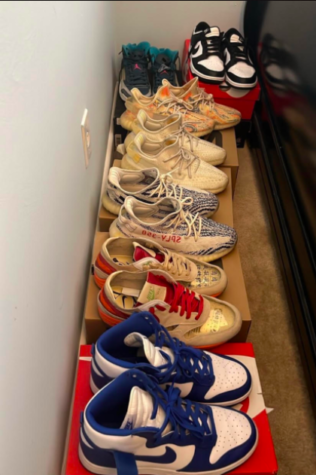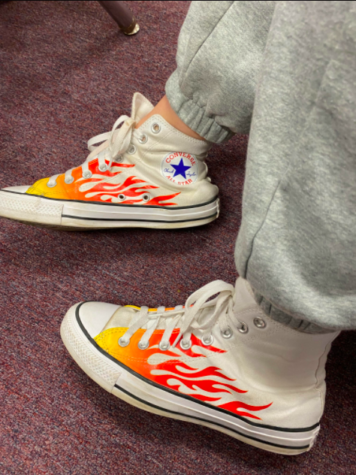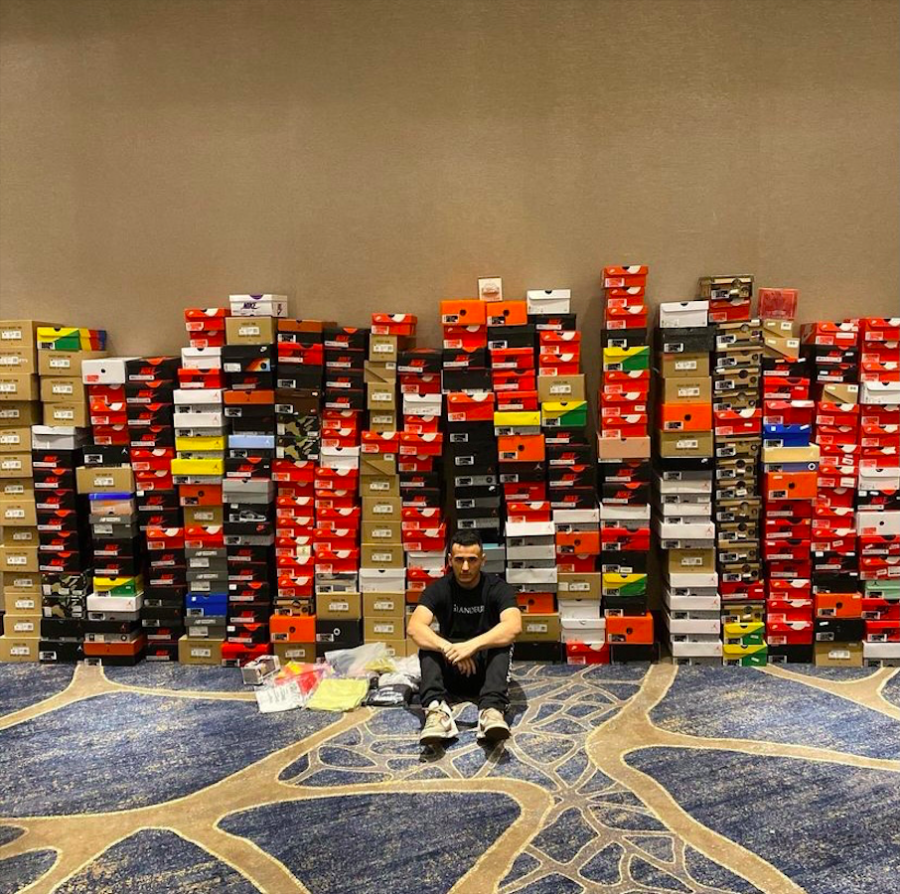Students, stocks, and sneakers
How some students are freelancing their way to financial stability
Photo courtesy of Gautam Malik
Gautam Malik’s stock at his store
Ice cream scoopers and cash register employees are what many think of when the topic of student jobs is brought up. However, these days some students have been getting more bang for their buck online. Inside the school is a small sub culture of resellers and stocked-up students who trade crypto, buy non-fungible tokens (NFTs) and sell sneakers.
“When I first started I was making $200 to $300 a month,” Dylan Purka, a senior who has been reselling sneakers since sophomore year, said.
Every day he spends about two hours researching shoes to buy and resell for profit, and shipping shoes out to buyers.
“First, you have to do the research all about the shoe,” Purka said. “Like the price work, where it drops, where all the shoes are coming from, and what’s the best strategy of getting them. Then you actually get the shoe, you wait to get it at your house, and then you sell [it] through either GOAT or Ebay.”
Purka also consults his friend Ayaan Syed, a fellow senior who resells shoes and clothes. They are often seen in Generals’ Period hyping each other up and bouncing ideas off of one another for future sales.
“The shoes I’m wearing right now are dunk highs, the Kentucky ones,” Syed said. “Retail they were $100, resell they’re $200. Somebody who would resell it would have to pay taxes and shipping fees, but they’d make about $100. That’s how you make money and you keep going.”
Syed first got into the sneaker culture after his cousin gave him a pair of $500 Yeezys in his sophomore year. He started buying more and selling them after that. Currently he has 12 pairs of sneakers that he bought from Stock-X, GOAT, and Ebay, as well as the official websites. Not only does he sell to buyers across the country, but to other students at school as well.
“Sometimes people post on their SnapChat stories with a picture of the shoe and say something like ‘quality 10/10,’ or if they were worn once 8/10, and the price they’re reselling it for,” Syed said.
“Sneaker Heads,” or people who are part of the sub-sneaker culture, have two categories: those who buy the shoe based on the design and those who buy them because of how expensive they are. This makes top shoes such as the Nike Dunks and Kanye Yeezys, though popular and expensive, stir debate within the sneaker community.
“There’s like a lot of people in general and in the school who spend like $300 on a pair of shoes just because it’s $300,” Syed said. “Not because they know anything about the shoes. They have no appreciation for the culture. They just want to look nice.”
Regardless, the expense of the shoes are undeniable. Selling a pair would create large profit for the buyer, though they are hard to obtain. Many buyers enter company events such as raffles for a chance to get a top notch shoe, Purka among them.
“I got these pair of shoes that was an early release of the very hyped A Ma Maniere
Jordan 3s back in May-ish,” Purka said. “There was a raffle on their main site, and the odds of getting this was crazy. It’s like winning the lottery. It was definitely like a million entries to one and I got it, I got the shoe. I could not believe it. At that time it was going for $1,000, So I was able to sell them for $1,000. That’s the most I’ve made off a pair of shoes.”
Impossible odds are not the only extreme; Syed snagged a pair while waiting in line for the SAT.
“I was waiting in line for the SAT in August and I got a notification on my phone that these pair of Yeezys dropped,” Syed said. “So I went on Dick’s Sporting Goods and I had to wait in a 30 minute cube while I was waiting in line for the SAT and I was able to get the pair of shoes.”
Chances like these are rare and far between, making chances of actually getting a shoe almost impossible. Many resellers have a solution to this: automated bots, Artificial Intelligence (AI) that can buy large quantities of shoes merely seconds after they are released online.
Although the rewards are high, resellers have a hefty cost to pay for a well functioning bot. Most do not come cheap, and good ones are hard to find.
“If you wanted a really good bot, it would be like $4,000 to $10,000,” Purka said. “That’s crazy. It’s not even comprehendible, but I mean like if you’re getting shoes that you’re able to sell and you’re doing this over and over and over again, eventually you’re gonna make that money back, and then you’ll be able to sell the bot for the original price.”
Unfortunately for the manual buyers, the chances of buying high quality shoes are diminished even more and many are forced to buy from the resellers instead.
“A lot of people who are casual or not reselling are kind of mad about that because we’re not able to get a pair of shoes because bots took it already and it sold out too quickly,” Syed said. “People do not like resellers, especially resellers with bots.”
That is how it has been for a few years, but the tide is changing. Now that more and more people are reselling shoes, the market is beginning to jam.

“What happened was the entire market got undercut by people who were just trying to quickly flip them [sell shoes quickly for cheap],” Purka said. “So it’s kind of like the resellers ate up the resellers.”
These sellers are often referred to as “Jerrys” and have effectively plummeted the prices shoes and bots were originally aiming for by selling shoes just as quickly and for cheap. Those who did not leave the market quick enough were stuck with losing massive amounts of money.
“This one that I bought back in April for $700, at one point it went up to $1400, went down to $900, went down to $600, then went down to $50,” Purka said. “The market was incredibly volatile around September and October because nothing was dropping and everyone kind of realized that ‘it’s a dead business, I just need to get rid of my stuff and leave it’ and I didn’t leave it. So now I’m stuck with losing $650.”
Many resellers moved on to selling clothes, hats, and gaming setups instead.
“The newest thing is consoles,” Purka said. “PS5s, X-boxes, those are the new things that everyone’s like going for because they hold the most value, because they’re such little stock, but there’s such high demand. Like for example, literally an hour before this, I got a PS5 in class. Like I was just sitting there and I got it. It retails for $500 but then it goes for $1000. So I’m doubling my money, why would I deal with shoes? That’s the whole idea, it’s such a better business and everyone’s moving over to it.”
Not all shoe resellers are dying out; some are thriving in these conditions. Senior Jonah Bierman has been selling shoes since middle school. Now he works at Grandeur, a shoe resale store in Tysons Mall he opened with Washington-Liberty alumni Gautam Malik last year. The two used to resell and run sneaker conventions together for years earlier. They opened on May 1, 2020 and have since seen tremendous profits.
“Because we have a storefront, we don’t have as many competitors, and we’re able to charge over-market. It’s a lot easier,” Bierman said. “It’s actually gotten a lot better for us, because everyone’s turning into resellers. It’s really hard if you’re starting off without much money, but because we have the capital we’re able to buy from those people and still make money, it’s better for us.”
Through their store they are able to buy shoes for cheap from the excessive number of resellers and sell for higher prices or make special deals for lower ones.
“We run a group chat where we charge people $45 a month to know everything about what’s selling and give them shoes for undervalue. So if we have a shoe that’s $500, we’ll sell it for $200, and we’ll lose some money there but we’ll make it back through memberships.”
The store has been so successful that they intend on opening a second resale store exclusively for clothes in the near future. Unfortunately, not everyone was having such luck. Much of shoe culture was tainted with impulsivity and regret.
“When a shoe drops, if I want to buy retail I can’t put in any thought,” Syed said. “Because I literally have to go on that website and put in my credit card information instantly.”
That can get addictive and dangerous quickly, exceeding the limits of a fun hobby.
“The Yeezys that I got that I was talking about, they’re this pair of white Yeezys that turn yellow in the sun,” Syed said. “It’s kind of cool but I feel like I shouldn’t have spent that much money on them.”
Some parents were concerned that the buying and reselling was too close to gambling, potentially leading to a dangerous addiction.
“My parents thought I was addicted to it by the way I was talking about it all the time,” Purka said. “I was like, ‘I’m making a lot of money by doing nothing, like I don’t see your issue with it’ … Eventually they realized that I know what I’m doing, and I’m not just feeding into it or gonna lose all my money at some point, and it wasn’t gambling.”
Part of the matter was that many students who had large amounts of money from reselling or small businesses didn’t have many demanding things to spend it on, other than college.
“I don’t really have anything else to spend my money on,” Syed said. “It’s not like I’m buying food or paying rent or anything like that, so I just buy a lot of shoes and clothes.”

An opportunity for better money management rose with the Washington-Liberty Stock Market Simulation Club. The club was founded and is run by club president senior Andrew Arabshahi, who wanted a way for students to learn to use stock as a method of income.
Stock market simulation club fundraiser stand at the holiday bazaar
“We discussed in our club that research and understanding is what takes this practice away from gambling and towards a smart financial decision that will benefit you more than a savings account,” Arabshahi said.
The club runs a live simulation of the current stock market where students can learn how to invest safely, as well as make friends with people with similar interests.
“The simulation is a supplement of the other things we do, which are talking about market news, strategies, perspectives, and just overall having discussion and activities to learn about the stock market,” Arabshahi said. “How to invest responsibly and how to invest with the mechanics of the stock market in today’s world.”
Arabshahi puts emphasis on learning how to use the stocks and makes sure everyone understands the basics before getting into more complicated markets.
“At the start of every simulation I give students two stocks that they have to choose between, just to ensure that everyone understands the mechanics of trading,” Arabshahi said.
After that, students are free to roam on their own with guidance from Arabshahi and other club leaders.
“We talked about the current news, students picked one of the stocks, and then bought it with the simulated money,” Arabshahi said. “With that activity, they were allowed to buy however much they wanted, even if it was just one share or less than one share. They’re also allowed to hold it for as long as they want. If they wanted to buy it, and make sure everything worked by selling it immediately for the same price they got it, they were able to do that. Or they were able to hold it for the entirety of that simulation, hoping that the price would go up.”
Some club members including Arabshahi also invest in stocks outside of the simulated market.
“I’m invested in a variety of stocks. For the most part I engage with technology stocks, fast pace innovative companies, such as electric vehicle companies,” Arabshahi said. “I would say companies that I believe in. I’m able to understand how their business works and I have faith in their future.”

Stocks are not the end of student investment, though. Some students have even started working with Cryptocurrency and NFTs,
“One of the biggest things that happened during this time (shoe market crash) was the NFT explosion,” Purka said. “When that comes up and people are able to take $3 and flip it into $10,000 they’re like, ‘Oh my gosh, why am I dealing with shoes, I’m gonna sell everything, put all my money into entities and then make money that way.’”
Students like senior Shaw Neumann did exactly that. This year, not only did he purchase NFTs, but bitcoin as well.
“NFT’s are basically non-fungible-tokens,” Neumann said. “The difference between fungible-tokens and non-fungible-tokens is that Bitcoin, or Etherium or Litecoin all have the exact same value as another coin. Now a non fungible token means that they can still have value, but one is not the same as another one, so one token can be worth 10 times another token, even if they’re identical.”
One of the cryptos Neumann interacts with are CyberKongz, a type of currency that uses bananas instead of coins.
“CyberKongz are fascinating, every day they give you 10 Bananas, which is a crypto currency known as a fungible token,” Neumann said. “Since it’s fungible, that means every banana is worth the exact same. So bananas are marketed or listed around $50 each. If you get 10 of them a day that’s $500, in a year that’s around $183,000. That’s just off one image, so imagine if you got like five or 10 when they first launched.”
He’s even considered making NFTs to sell by himself. He was inspired by a 14-year-old highschool freshman from across the country named Abigail, also known as “PeachSunday”, who made a large number of NFTs as a joke but ended up making about $1 Million in profit.
“She made about 10,000 of them just by using the basic Adobe Photoshop,” Neumann said. “She then just listed them thinking, ‘oh, cool, this would just be fun to do,’ And now that kid has made like a million off of them.”
The NFTs depicted customizable cartoon whales called “Belugies” with over 8,000 images, most of which she had simply drawn using her iPhone. Over all she made about $1 Million in profits, 20% of which she donated to charities such as The Sunshine Kids. To hear more about Abigail’s story click here.

An NFT actually is not very difficult to make. A basic NFT requires at least 1,000 to 10,000 images with similar features that vary with specific features. Some NFTs have above 100,000 images. The images can be of anything, as long as they are customizable and vary in rarity levels. Using a program such as Adobe Photoshop, anyone can create an NFT if they have the time, regardless of skill level.
“I have bought a few NFT’s and I have not made one yet, but I definitely am interested in it because there’s just so many cool features,” Neumann said. “Especially with web three coming out that can be incorporated into it.”
Web 3, the upgrade of the internet, would take power away from big programs such as Google, Facebook, and Instagram by allowing anyone to create a website or program on the internet without buying space from big corporations.
“Web 3 basically revolves around blockchain and all that stuff,” Neumann said. “So instead of all the internet servers being hosted by Google, or one location, the internet would be hosted by everyone currently using the internet.”
NFTs may see an upgrade as well. Even some songs are NFTs. There’s a chance that in the future movie or sports tickets will become widespread as well.
“To be honest, it kind of just seems like they’re the future,” Neumann said. “Like movie tickets and sporting events tickets, and all those tickets will probably at one point be NFT’s. So in like 20-30 years from now, you have a NFT ticket from a baseball game in like 2022 where someone got like a grand slam, just the ticket itself could be worth a bunch of money even though it was like a while ago, and so that could be pretty cool.”
NFTs, Crypto, and Stock are becoming more and more relevant in students’ futures. Some plan to use the methods of income well beyond college.
“I plan to manage and be proactive with my personal financing, which will include stock market investing, throughout the rest of my life,” Arabshahi said.
One thing that is sure to stick with students is the culture that comes with stocks and reselling, as well as the sense of community it creates.
“I feel like the shoe culture in college is even bigger than the one here,” Syed said. “Colleges are bigger so obviously there’s more people. [My cousin] said there’s like a big shoe culture and stuff and people bring all of their shoes from back home to their dorm, like every single pair, and they’re walking with a pair every single day.”
The future of personal finance isn’t only about money and sales, it is also about art, community, and modern culture. Many students now have opportunities to express themselves in a way that can support them financially and help them in the growing world.
“It’s definitely more than money, it’s more than the profits, it’s just about expression,” Bierman said.










